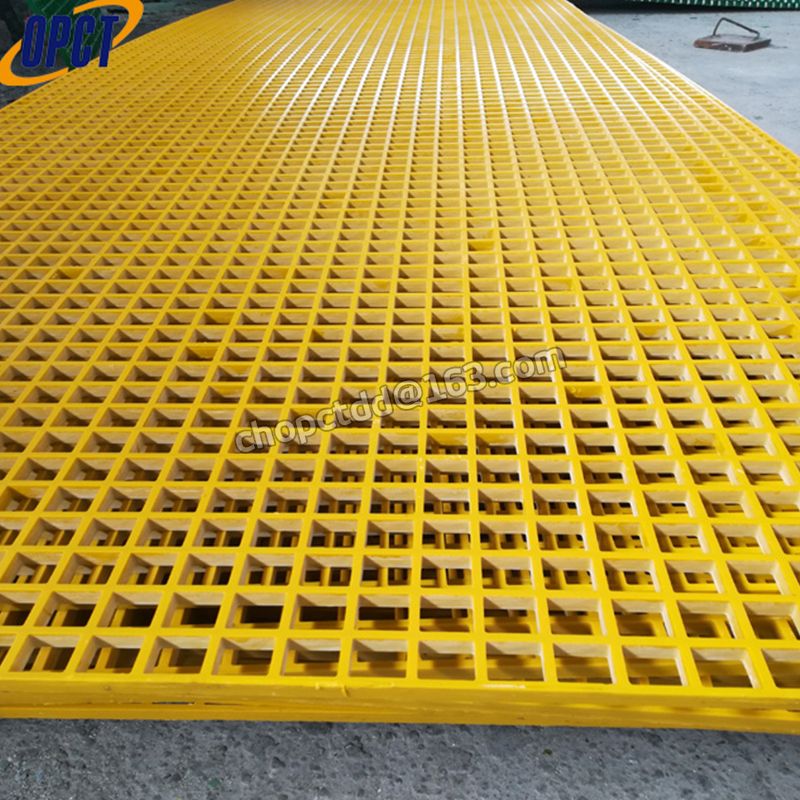FRP Molded Gratings
FRP Molded Gratings
FRP (fiber-reinforced plastic) is an alternative to flooring products such as aluminum or stainless steel grating to prevents caustic or corrosive environments. FRP is used for flooring, especially for access walkways, platforms, screening, battery racks, bridges, and stair treads.
FRP grating is available in various resins, standard and custom colors, depths, panel sizes, and mesh configurations. Surface options include a meniscus or integrally applied grit top, which offers superior, slip-resistant footing. FRP molded gratings are used in place of traditional materials.

Advantages of FRP Molded Gratings
● Corrosion Resistant
● Bi-directional Strength
● Slip Resistant
● Low Maintenance
● High Strength to Weight Ratio
● Fire Retardant
● Lightweight
● Impact Resistant
● Long Service Life
● Superior Ergonomics
Pultruded Fiberglass Grating Process
A machine that operates much like a caterpillar in form, first grabs the raw materials (resin and glass). Then, it “pulls” them through a series of steps that blends the raw materials into a new composite.
Fiberglass roving and mat is pulled through specifically shaped guides on an automated machine continuously. It’s very similar to the way many hard candies are made if you have ever seen that process. After it’s been pulled through the necessary steps it’s given a resin bath.
Next, it is wrapped completely with a thin surface veil that gives the product it’s additional traits (anti-corrosion, fireproof, etc.) Then, it is pulled again, this time through a die that has been heated so it can shape the product.
The reason fiberglass grating is so strong is that the material has a high glass-to-resin ratio as previously mentioned. This increases the load rating and the stiffness of the grating, making it highly valuable in industrial settings.
This type of FRP grating offers us the ability to create a wide variation of panel sizes, and flexibility in installations because we assemble it, we don’t mold it. Additionally, this also reduces waste and unusable scraps that you find with the molded variety of fiberglass grating production. But that is not even scratching the surface of its benefits.
THE STANDOUT BENEFITS OF PULTRUDED FIBERGLASS GRATING
While reducing waste and making more efficient use of resources are great benefits, there is so much more. Naturally, efficiency translates into bottom-line impact so that is, of course, a highlighted benefit. But you might be surprised to know that many of the benefits indirectly impact bottom line also.
Corrosion resistance
Pultruded fiberglass grating has the same strength of steel despite it being much lighter. However, where it trumps steel is in its superior corrosion resistance. Steel rusts in harsh conditions and moisture or chemical exposure—you can’t stop it. Conversely, fiberglass grating does not corrode and can be used in any harsh environment without a hint of corrosion.
Whether it’s a waterpark exposed with corrosive chlorine or a battery plant with sulfuric acid—fiberglass grating is unaffected. You cannot accomplish that with steel or other types of metal, and wood doesn’t handle moisture well.
Fiberglass Grating Is Safer
Our pultruded grating also includes a special coating for traction to prevent slip and falls. This helps companies stay OSHA compliant and mitigate liabilities from workplace accidents.
Also, in environments where there might be electrical hazards, steel is conductive where fiberglass is not. This can save someone from potential electrocution should there be an accident. Similarly, in areas where radio communication is a key to safety, fiberglass will not interfere, but steel does. There are no reception barriers since radio waves are unaffected by non-metal structures.
Long Service Life
Our grating has the ability to withstand just about anything you can throw at it. The resin is what provides resistance to the many environments it may face. For example, corrosion, UV ray exposure, impact, and fire. All of these hazards that could be detrimental for metal and wood aren’t a problem for fiberglass grating.
Easy Fabrication With Fiberglass Grating
One of the biggest hurdles when installing steel grating and structural components is well—everything. Steel is heavy, expensive to ship, requires concrete reinforcement in most cases, and just cumbersome to move.
Ironically, fiberglass grating can be assembled easily, needs no special prep work, and is inexpensive to ship. Since FRP grating is so light you don’t need special equipment to move it or a huge crew. In fact, because FRP is equal to strength in steel you can use it as a 1:1 replacement for many things. It will work harder and last longer than steel with a fraction of the install work.
MOLDED FIBERGLASS GRATING
While pultruded FRP grating and molded FRP grating share many similar qualities, some of their applications are different. However, just like pultruded grating, many of the benefits that make all FRP products superior are the same.
Molded Fiberglass Gratings Process
With molded grating, rather than pulling the resin and glass through the necessary steps, molded grating takes a different approach. In this method, the resin and fiberglass rovings are laid into a mold in repeated layers. The panel thickness and dimensions vary according to the application needs but the process is the same.
Once this is completed to specifications the mold is left to cure. Once it has cured, the panel is loosened from the mold, cleaned, and then the process starts all over.
Molded fiberglass grating ensures its sturdiness and quality by being cast in one piece. There are no joints between the bearing bars. Additionally, as with pultruded, the high resin content also gives superior corrosion and impact resistance. One unique note, molded fiberglass grating that is created with a square mesh pattern offers better load capacity.
ADDITIONAL MOLDED FIBERGLASS GRATING BENEFITS
Corrosion resistance is just one of the many benefits shared by molded grating as well. It’s also strong, long-lasting, and stands up to harsh environments like pultruded. Top-surface coatings can also add benefits like slip resistance and traction. Molded FRP grating is also great for pool decks, pedestals, stair treads, and more.
Easy To Keep Stock On Hand
Many standard sizes of molded grating can be prepared and shipped for storage until needed. We can also make custom sizes and shapes that meet your project needs. We’re also able to design, fabricate and install your entire fiberglass grating system including stairs, platforms and more.
Long Service Life
Just like pultruded fiberglass grating, you will get a very long service life from molded FRP grating. Molded grating doesn’t even need to be painted since the color is molded in and it lasts longer than metal.
Since molded uses interwoven mesh construction, it has greater bi-directional strength. This means you can cut the grating to fit your needs and there is less waste versus metal.
Fabrication Is Simple
You can simply cut molded fiberglass grating to size with standard tools, just like its pultruded counterpart.
YOU CAN’T GO WRONG WITH FIBERGLASS GRATING FROM DONGDING
It’s pretty obvious from the stated benefits and similarities, that both pultruded and molded FRP grating are invaluable. In fact, the benefits and traits are nearly identical—the only end difference is the applications each is best for.
Either way, you can’t go wrong when you go with DONGDING for your fiberglass grating needs. Let one of our project consultants help you balance your budget with DONGDING products. Contact us today!




